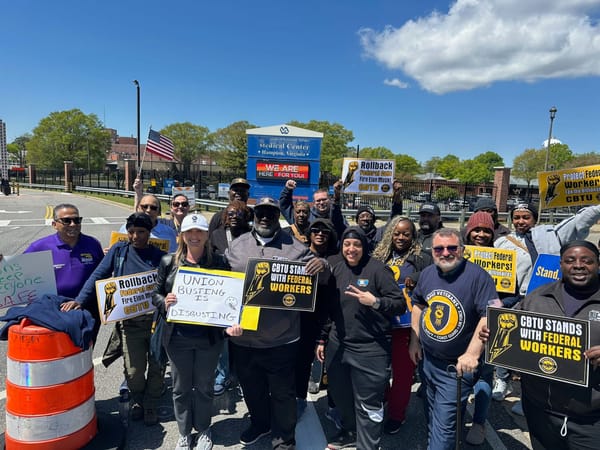The Disappearance of Kilmar Abrego Garcia
How one man’s state kidnapping reveals a window into how democracies learn to disappear people

How one man’s state kidnapping reveals a window into how democracies learn to disappear people
Kilmar Abrego Garcia had a union card, a legal status, and a child with autism who couldn’t speak. By every measure, he was living the promise that America makes. Then ICE snatched him off the street in Baltimore and trafficked him to a Salvadoran mega-prison without charge or trial—what officials now call an “administrative error.”
The State Department says they can’t do anything. The Justice Department says he’s out of reach. And Donald Trump says he loves the idea of deporting U.S. citizens, too .
This is not just about Garcia.
This is about what happens when a state learns to disappear people.
From Maryland to a Mega-Prison
Garcia had been granted protected status in 2019 after fleeing gang violence in El Salvador. But in March, ICE declared—falsely—that his status had changed and deported him to CECOT, the notorious Salvadoran prison described by human rights groups as a “black site” for torture, forced labor, and death . His family wasn’t informed. His union—the Sheet Metal Workers of SMART—found out before they did.
The Supreme Court ordered the administration to facilitate Garcia’s return. The White House is slow-walking their response, dragging things out and daring the courts, make me. Meanwhile, Garcia rots.
“Bring Him Home”
Garcia’s union brothers and sisters didn’t stay quiet. SMART rallied, fundraised, and mobilized. At a national trades convention, their demand thundered across the room: “Bring him home!”
This isn’t just solidarity. It’s a warning. What happened to Garcia isn’t a fluke. It’s a blueprint.
Ecuador Is the Model
Nearly 200 people have now been disappeared into El Salvador’s CECOT prison—most without notice, many without charges, some without even their names recorded. The U.S. sent them. And the government’s legal argument is chilling: once deported, even illegally, these people are no longer in U.S. custody—therefore no court can compel their return. It’s a blueprint built on plausible deniability. CECOT becomes a place to send people the government wants to vanish.
In the 1980s, Ecuador disappeared its own citizens too. Under U.S.-backed military leadership, intelligence units worked hand-in-hand with death squads to detain, torture, and execute suspected subversives—trade unionists, student organizers, leftist clergy. Few were formally charged. Fewer still returned. The practice was rarely acknowledged and almost never prosecuted. It relied on what scholars later called an infrastructure of impunity: blacklists, black sites, and black holes in the legal record.
Today, that same prison system is being repurposed with U.S. funding. Migrants the Trump administration labels “terrorists” are shipped to Salvadoran facilities like CECOT, where human rights monitors are barred and due process does not exist. Once there, the government argues, they are beyond the reach of American courts. It starts with gang allegations. It ends with a legal black hole. We’ve seen this before.
Domestic Echoes
While the administration expands deportation pipelines abroad, it’s sharpening its tools at home. Using wartime laws and expanded definitions of “antisemitism,” Trump’s government is targeting Palestinian students, progressive Jews, and anti-war protesters .
They’ve redefined dissent as hate speech. Criticism of Israel as discrimination. And now, removal of immigrants as a constitutional norm—even for naturalized U.S. citizens .
The rhetoric has escalated. So have the policies. Trump’s team is exploring ways to deport citizens. They’re floating legal theories. They’re testing boundaries .
All it takes is silence.
First They Came
The logic is familiar: start with migrants. Target the marginal. Then expand the list.
It’s not just the cruelty of the deportations that’s shocking—it’s the brazenness. They admit the mistake. They just won’t correct it.
What Comes Next
The courts are slow. Congress is gridlocked. And administrative “errors” now come with armed agents and international transfers. But there is a movement building: in unions, on campuses, in faith communities.
It starts by naming what happened.
Kilmar Abrego Garcia was disappeared.
Not by mistake. By design.
For now, we wait. But not idly.
We document. We organize. We stay loud.
And if Kilmar Abrego Garcia is not returned, then this isn’t just a story about one man. It’s a signal that something foundational is being torn away—and that every one of us has a decision to make about what happens next.
Sources / Further Reading
- The Rude Pundit (CW: Rude language)
The Release of Kilmar Abrego Garcia Is the Issue We All Need to Rally Behind - Slate on the legal black hole of CECOT
Trump is asking the Supreme Court to let him have black sites. - The Guardian on antisemitism and political control
The new definition of antisemitism is transforming America – and serving a Christian nationalist plan - The New Republic on citizen deportation threats
Trump Has a New Target for His Mass Deportations U.S. Citizens - The Hill on denaturalization and Operation Second Look
The Trump administration’s next target naturalized US citizens - HuffPost confirming plans to deport citizens
White House Confirms Trump Is Exploring Ways To ‘Deport’ U.S. Citizens


